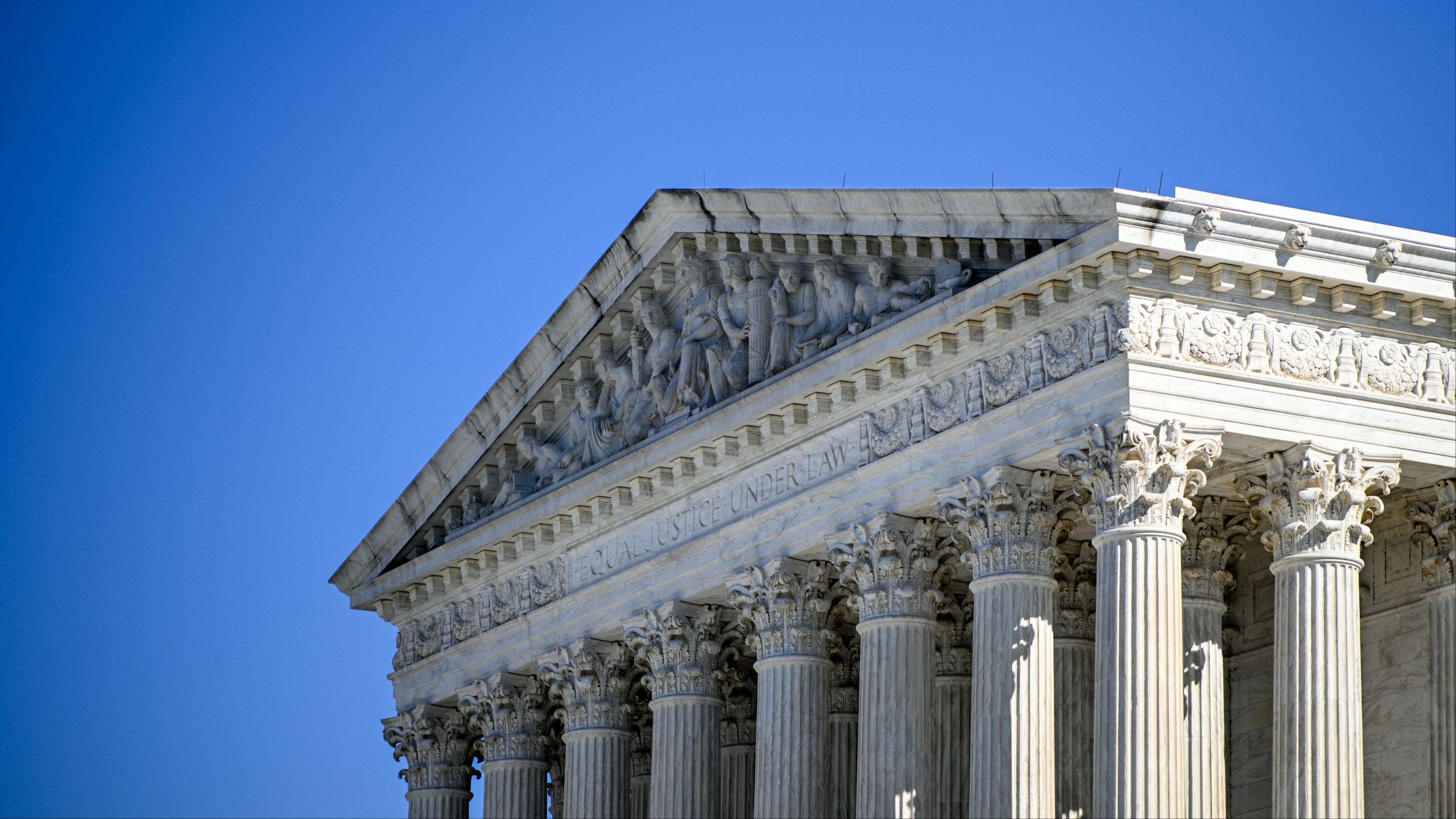Maine
Rooks: A shadow over Maine Legislature’s gun debate

There’s no question the Maine Legislature will begin the 2024 session in a tough place.
The majority in both chambers have longstanding disagreements with their fellow Democrat, Gov. Janet Mills, over a number of issues, including firearms safety.
The Lewiston massacre on Oct. 25 demands a state response, but what that response should be is uncertain, and will be further shaped by what can actually become law. To their credit, both Mills and legislative leaders have proceeded cautiously.
One point they should be able to agree on is that the U.S. Supreme Court’s confusing edicts about firearms shouldn’t influence the laws they write.
Only in the grievous Dobbs decision on abortion has the court acted so rashly and so out of keeping with the history and traditions of the Constitution, and the common law.
Clarence Thomas’s majority opinion in the 2022 Bruen decision hasn’t elicited the same outrage as Samuel Alito’s historical misstatements in Dobbs, yet it’s equally unfortunate.
Thomas’s poor grasp of precedent and tradition is captured in Bruen’s most noteworthy assertion: “Only if a firearm regulation is consistent with this Nation’s historical tradition may a court conclude that the individual’s conduct falls outside the Second Amendment’s ‘unqualified command.’”
This “unqualified command” exists only in Thomas’s mind, not in any convincing reading of the Constitution.
For more than 200 years, federal courts understood the Second Amendment to buttress the common defense – not individual ownership of firearms. That changed with the late Justice Antonin Scalia’s opinion in the Heller case in 2008 striking down the District of Columbia’s handgun ban.
Banning guns of any sort has become contested in a way it never was until the 21st century.
Gun ownership was once defended in connection with hunting — certainly the case in Maine — and not primarily owning a gun for “protection.”
Yet the connection with guns and “feeling safe” has been pursued with such extraordinary avidity it’s been seriously proposed, and even legislated in some states, that the “solution” to elementary school students being massacred is to arm and train their teachers.
So with an increasing conservative tilt, the court reached the point in 2008 where Scalia — more respected than Thomas or Alito — decided a comprehensive, not especially effective handgun ban in the nation’s capital had to go.
To do so he could not call on precedent. So he made up a new constitutional principle by ignoring the Second Amendment’s militia clause and focusing solely on “keep and bear arms.”
At the time, it didn’t seem monumental. Few states or cities tried to ban handguns.
Then came Bruen, and, constitutionally, all hell has broken loose. Federal appeals courts have struck down all manner of firearms laws in response.
It turns out the “nation’s historical traditions,” as twisted by the conservative majority, isn’t a helpful guide.
Recognizing the chaos, the Supreme Court itself seems ready to limit the damage. In the Rahimi case currently before the court, oral arguments showed a majority, perhaps even a unanimous court, inclined to uphold laws removing firearms following domestic violence offenses.
How the court proceeds afterward is unknowable. Unlike the D.C. handgun ban, New York state’s concealed weapons permit system struck down in Bruen was similar to laws in most states — including Maine at one time.
Maine’s permit system was repealed in 2015 when Democrats, who’d pushed for a uniform system run by State Police, abandoned the effort and agreed to scuttle the entire law.
The only real advice one can offer Maine leaders, of both parties and all three branches of government — a former chief justice is leading the Lewiston investigation — is to do what’s right for Maine, without worrying about what might happen in court.
We’ve traveled a long way from when federal legislation limited access to firearms, as in 1968 after the assassinations of a president, his brother, and the 20th century’s greatest civil rights leader.
Much of that journey has been in the wrong direction.
Changing course won’t happen through any single action, or any position taken by an elected leader, though the declaration of conscience by Congressman Jared Golden could help point the way.
Lyndon Johnson, whose great legacy in domestic legislation was forever tarnished by the Vietnam War, isn’t the first Democrat who comes to mind when the word “statesman” is mentioned.
Yet Johnson had one undeniable insight that could serve Maine well.
In his earlier days as Senate leader, cooperating extensively with Republican President Dwight Eisenhower, Johnson often led with a verse from Isaiah: “Come, let us reason together.”
Responding to the Lewiston tragedies will be the work of years, but reasoning together is an excellent place to start.
Douglas Rooks has been a Maine editor, columnist and reporter since 1984. His new book, “Calm Command: U.S. Chief Justice Melville Fuller in His Times, 1888-1910,” is available in bookstores and from Maine Authors Publishing. He welcomes comment at drooks@tds.net

Maine
Ace Flagg is ready to be a star again in Maine


Ace Flagg is a power forward on the Greensboro Day School boys basketball team. Flagg will attend the University of Maine next year. Auden Forsberg/Greensboro Day School
It was a hard decision to make. For a while, at least.
The summer before Ace Flagg’s senior year was nearing its end, as was the time to make a decision on his college basketball future. He had plenty of options to choose from — Division I colleges from across the country had made their pitches.
One, though, always stood out.
“When I started weighing all the options and everything that it meant to me, I think it became pretty obvious, pretty quickly,” he said. “I knew I wanted to come home.”
It’s been nearly two months since the Newport native announced his commitment to the University of Maine men’s basketball team.
It made news around the country, and fans celebrated when Flagg made his homecoming official. After all, Ace and his twin brother, Cooper — a freshman star at Duke — have captivated the state since their high school debuts at Nokomis Regional High three years ago.
“I liked everything about it. It was great to see the attention it got, and all the support and love from all the Mainers,” he said. “It was amazing. It helped me so much. It made the whole thing a lot easier. I’ve been blessed to be able to play in Maine and have the support of everyone there.”
Flagg feels fortunate, as does his future team.
“I just love what he brings to the table, in terms of his toughness, his basketball IQ, his inside-out skill set,” Maine coach Chris Markwood said. “He’s our type of guy. He’s a Maine guy, hard-working, tough, hard-nosed and a great feel for the game.”
The announcement, though, was only part of what’s been an eventful season for Flagg. He’s also at his third school in four years, playing his senior year for Greensboro Day School in Greensboro, North Carolina. He’s adjusting to life without Cooper, on the court without his brother for the first time.


Ace Flagg averaged 12.7 points and 7.2 rebounds through his first 15 games for Greensboro Day School. Auden Forsberg/Greensboro Day School
Everything has been new: the environment, teammates, coaches and friends. He’s had to learn a new game, one that’s going to better prepare him for the college level that awaits him, and embrace a new role as a team leader.
“So far, so good,” Flagg said in a phone interview this week. “I wouldn’t say I was anxious. More just interested … to see what it would be like.
“It’s been a smooth transition, and I honestly feel like I’ve been here longer than I have.”
‘He’s unique’
Flagg said Greensboro reminds him more of the schools he grew up attending than Montverde Academy in Florida did.
“It feels a lot more like a public school, almost,” he said. “Greensboro has a more open kind of feel to it. … (There are) a lot of local kids, and not a lot of kids from all over the country.”
The kid from Maine, however, can only blend in so much.
“They do like to call me a Yankee, that is true,” he said. “They like to try to be country boys, but I tell them north is country, south isn’t. Which they don’t like.”
Flagg has made it a point to ingratiate himself with not just the team, but the community. Several of his closest friends aren’t basketball players. When Greensboro coach Freddy Johnson hosted a rec league with teams of third-, fourth- and fifth-graders, he asked Ace to work with a couple of the teams. Flagg instead spent hours working with all six.
“He’s unique,” Johnson said. “I like being around him, because he’s just such a good kid.”


Cooper Flagg, left, and his brother, Ace, share a laugh during a youth basketball camp on Aug. 10 in Orono. Anna Chadwick/Morning Sentinel
He’s also had to adjust to not sharing the court with Cooper for the first time since middle school. Flagg said there’s now more on his shoulders, which can help him as he prepares for college.
“Playing with Cooper makes the game easier,” Flagg said. “After playing with him for so long, not having him just makes everything tougher. You have to do a lot more on your own when you don’t have a player like him with you. But that’s not necessarily a bad thing. It’s going to push me to be even better than I would have been before.”
Being Cooper’s brother, let alone twin, creates a shadow that is tough to escape, given Cooper’s status as the country’s most coveted college prospect. Ace, however, said there were “no hard feelings at all” on his part as he watches the buzz around Cooper soar.
“I’m super proud of him and everything he’s doing. He deserves everything that he’s got, he’s worked so hard. Seeing all this attention for him is just amazing,” he said. “I want him to succeed more than maybe he does. I have nothing but love for him and hope nothing but the best for him.”
Growing his game
Johnson didn’t have much of a scouting report on Flagg when he came aboard in July.
“I really didn’t know much about him, other than he was a good basketball player,” said Johnson, who earlier this month became the sixth high school coach to reach 1,200 career wins. “He has a lot of respect from a lot of different people.”
Johnson quickly saw the tools Flagg had, and the set of abilities that have helped him average 12.7 points and 7.2 rebounds per game (as of Tuesday) while leading the 13-2 Bengals in minutes.
“His feet are unbelievable,” he said. “He has such good movement, he knows how to fake and get guys up. He can go around a 6-9 guy. … He passes like a point guard.”
It’s been a season of adjustment and acclimation, however. A pure forward who played as a big man with Nokomis and Montverde Academy in Florida, the 6-foot-7 Flagg has been playing more on the perimeter for a Greensboro team that likes to run and has four players around the center playing positions based on matchups.
“I’ve started to play out further, closer maybe to a 3 (small forward) than a 4 (power forward), and playing a lot out on the wing,” he said. “It’s one of the things that I needed. Playing that 4, 5 role at 6-(foot-)7, it doesn’t usually work out. I knew I needed to start transitioning outside and sharpen up my skills there.”


Ace Flagg looks for an open teammate while playing for Montverde Academy during a game in Portland on Jan. 6. Ben McCanna/Staff Photographer
It didn’t click right away. Flagg was unselfish to a fault while playing with his new teammates, and Johnson spoke to him about taking over with the ball.
“Around game 5, 6, I reminded him that he needed to be more assertive,” he said. “He wanted to keep all his teammates happy by sharing the ball, and I explained to him that we’re not running five plays for him to catch the ball and throw it to somebody else. We want him to take it and score.”
The chat worked.
“If you saw him play the first three games and you saw him play the last three games, he’s a totally different player,” Johnson said.
A home state spotlight
It’s not as if Ace doesn’t generate his own hype and attention. Johnson said attendance at Greensboro games, both home and away, has climbed, and that the opportunity to cheer or jeer the player they’ve seen in stories and video clips online is likely what’s brought the fans out.
“He has his fan section that comes to cheer against him,” Johnson said. “We draw more on the road than we ever have.”
When he committed to Maine on Oct. 30, the news stretched beyond the state and even landed as a headline on ESPN’s homepage. He’s been in the spotlight for a while, but Flagg said those moments don’t get old.
“It’s definitely a little weird,” he said. “Growing up, you’re always watching games on ESPN. Seeing yourself on there is definitely a strange feeling.”
Flagg announced his Maine commitment on Instagram, sharing a SportsCenter post, and the post has garnered 215,000 likes and 710 comments. News quickly reverberated around the state and zipped through the Orono campus.
“When the news hit, that was the big talk around the rec (center). ‘Ace is coming, Ace is coming,’” said Landen Chase, 19, a UMaine sophomore. “I had a friend who texted me, he doesn’t know a lot about basketball, but he texted me and his whole family was curious about why Ace was coming and what happened. It was cool. It was all around campus, everyone was talking about it.”
It’s buzz that hasn’t been there for a program that went 28-105 between the 2017-18 and 2021-22 seasons.


Ace Flagg drives to the basket while playing for the Greensboro Day School boys basketball team. Flagg will attend the University of Maine next year. Auden Forsberg/Greensboro Day School
“They want to win (at Maine). It’s a winning mentality there,” Chase said. “People feel like, with Ace, this is going to step up our program and make games more enjoyable, and give us a better chance to win.”
That’s Markwood’s interest as he continues to try to build Maine into a contender in America East. Sure, having more eyeballs on the program is nice, and Markwood knows the Black Bears’ profile got a boost when Flagg signed.
“There’s obviously a major buzz behind him and obviously his brother, Coop. In Maine, those two guys, everybody’s watching them grow and evolve in the highest level,” he said. “I think everybody’s excited for Ace and for us, that we’re able to get a player of Ace’s caliber to come back home and represent our state.”
What Markwood is most interested in is what Flagg can do on the court, and how he can help continue the upward trend of a team that’s gone 36-39 since Markwood took over in 2022.
“He’s got a really good knack inside, he grew up as a big man, so he’s got great touch around the rim from 15 feet and in, and now he’s really added and developed his game around the perimeter,” Markwood said. “You’ve seen the evolution, and he’s still only scratching the surface.”
That’s Flagg’s focus as well.
“I’ve never played basketball in my life with the intention of not winning,” he said. “I’m trying to bring everything I can to win. That’s what I want to do.”
The pressure’s already there. Markwood said he won’t want to add to it.
“I want Ace to enjoy the process on his own journey, at his own speed,” he said. “I don’t want him to feel like he’s got to come in right away and be Michael Jordan. He’s got to come in and be himself.”
Whatever expectations await him, Flagg knows he’s ready for them.
“I look at it as a positive,” he said. “Being able to be recognized by anyone is a blessing. … I would never take it for granted. I think every day that I’m blessed for everything I have.”
Maine
What did Hallowell learn from the December 2023 flood?


Sam Joyall, co-owner of Rusticators Emporium on Water Street in downtown Hallowell, points out Thursday the high-water mark of last year’s December flood, the fifth-highest in the city’s history. Joyall says he noticed the water rising fast on the morning of Dec. 19, 2023, and he quickly called his wife. “I did a quick U-turn around, she booked it up there, and then we spent the rest of the day watching as that graph kept projecting it to go higher and higher for flooding.” Joe Phelan/Kennebec Journal
7:30 a.m., Tuesday, Dec. 19, 2023
Kennebec River at 17.3 feet: moderate flood stage
HALLOWELL — Power was out on Water Street, and Sam Joyall knew there was a cold spell coming. He drove from his home in Richmond to insulate his storefront, The Rusticators Emporium, from the dropping temperatures early Tuesday morning.
Joyall passed the boat launch on the southern end of downtown. It hadn’t rained for almost a day, but water encroached on the launch parking lot. Noted.
He continued on to his store, two blocks north of the launch, insulating supplies in hand.
“By the time I had stuffed the doors and was like, ‘OK, this is all I came here for,’ and was leaving, I noticed how — in that brief period — substantially higher the water was at the boat landing area,” he said.
A slow-moving storm had dropped 4-8 inches of rain across much of Maine over the previous two days, melting snowpack and quickly increasing river levels.
Joyall was seeing the beginning of what would become a historic flood. A year ago this week, riverside communities across central Maine suffered damage they will remember for decades — and as the climate changes, the storms that led to the flooding are expected to only increase in intensity.
It’s a time the communities can’t afford to forget. That December morning, experts say, will be repeated more frequently in the years ahead.
Front Street, which borders the river and lies much lower than the rest of downtown, had flooded the evening before. Hallowell’s bulkhead — where the famous colorful Adirondack chairs sit for much of the year — was already covered by several feet of water. The Kennebec River was rising by nearly a foot every hour.
Joyall called his wife, Lexi, who checked on the river’s flood gage predictions — and it did not look pretty. The duo, who co-own the store, scrambled to take action.
“I did a quick U-turn around, she booked it up there, and then we spent the rest of the day watching as that graph kept projecting it to go higher and higher for flooding,” Joyall said. “We were just in the shop, doing whatever it was we could — we took out some of our most expensive items, fearing that we were probably going to see some water come into the shop by that point.”
Floodwater soon lapped at the doorsteps of Water Street storefronts and completely inundated Front Street basement spaces.
And the river was still rising.

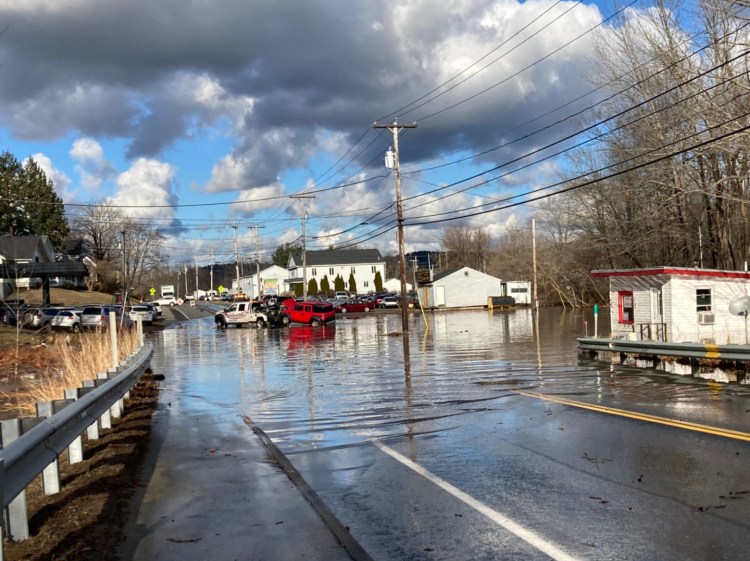
The town center of Hallowell was unreachable on the afternoon of Dec. 19, 2023, with both sides of Route 201 closed and cars coming from Gardiner being directed to turn around. Emily Duggan/Kennebec Journal file
10:30 a.m., Tuesday, Dec. 19, 2023
Kennebec River at 19.27 feet: major flood stage
Joyall spent the rest of the morning moving merchandise and watching the flood gage read higher and higher. Business owners up and down Water Street had the same idea — many scrambled to get their belongings to higher ground. Upstairs, up the hill — anything would do.
Down the street, Joyall saw volunteers, including Mayor George Lapointe, moving stock out of Vignettes of Maine — a gift shop near the corner of Water and Wharf streets — as the business took on water.
Chiseled into the building across Wharf Street, notches marking Hallowell’s biggest floods from the past 200 years loomed over Lapointe’s parked pickup truck. Nine months later, this flood’s high-water point would be marked on that building — the fifth-highest ever recorded in Hallowell and the highest since 1987.
Joyall called across Water Street to make sure Michel-Paul Cyr, who owns Michel Paul Artist Studio, had all the help he needed while water crept up to his gallery’s back deck. Lapointe jumped from business to business, asking owners how he could help.
On Front Street, the Quarry Tap Room’s back patio was submerged in 8 feet of water. Easy Street Lounge was filled with water “to the rafters,” and it took months for owner Bruce Mayo to rebuild and restock, Lapointe said.
Joyall said he stayed at The Rusticators Emporium for several more hours, watching the water slowly rise outside. He said the store’s lights and heat, which had been out since the day before, flickered back on, even before the water stopped climbing.
“Oh, this is a reverse Titanic situation here,” Joyall said to himself.
9:30 a.m., Wednesday, Dec. 20, 2023
Kennebec River at 17.97 feet: moderate flood stage
With power back on the western side of Water Street, City Manager Gary Lamb powered up the city’s computers and opened City Hall doors for business for the first time in two days.
The river had already noticeably dropped from its peak of 22.49 feet around 9 p.m. Tuesday, but roads were still impassable on the southern side of downtown until about midday, according to a memo Lamb wrote recapping the flood. Public works employees removed barricades and began cleanup, using the city’s snowblower’s power broom.


A swollen Kennebec River floods buildings on the back side of Water Street in Augusta after a severe rainstorm in December 2023. File photo courtesy of Dave Dostie
Much of downtown was covered in inches-thick silt that was “greasy as heck,” Lapointe said. Granite City Park, which had been underwater for about 36 hours, was caked in sediment. The building housing Vignettes of Maine and what was then Traverse Coffee Co. was lifted slightly off its foundation and required substantial structural work. The Quarry Tap Room’s outdoor stage had floated over a railing and onto Front Street. Several buildings in the southern part of downtown were evacuated due to a propane tank leak near Café de Bangkok. Floats from the boat launch had traveled downstream, despite being stored across the Water Street, away from the river. Merrill’s Bookshop lost eight tons of books.
Buildings on the western side of Water Street were mostly spared from the worst of the flooding, including Berry & Berry Floral, where Lapointe said he saw a “small puddle” inside during the worst of the flooding. The Rusticators Emporium, on the western side of the street, was kept mostly dry, too.
But on the eastern side of Water Street, closer to the river, flood waters were slow to recede, and power was still out through Wednesday night.
Lamb contacted Central Maine Power early Thursday morning, wondering when electricity would be restored and hoping businesses wouldn’t freeze up during the impending cold snap. He was told by customer service representatives that building owners and tenants would need to sign CMP’s post-flood power restoration form, signaling they understood the risks associated with turning power back on.
“Because so many of the services were inundated, they required this form to be filled out and signed by a master electrician who’d actually done an inspection,” Lamb said. “For obvious reasons, safety reasons; it could start a fire or hurt somebody.”
Lamb said he didn’t know about the form before the flood — buildings downtown hadn’t flooded this badly since he became city manager — but that city staff and other volunteers jumped in to contact relevant people as quickly as possible. Power was back on by Saturday morning.
“The critical part was people were going to have to drain their buildings,” Lamb said. “It was getting much colder after the waters receded and buildings were going to freeze up because they had gone for four or five days without power, and most of those places are relatively uninsulated. We were ecstatic that, right before Christmas, we got the power back on that Saturday.”
11 a.m., Thursday, Dec. 12, 2024
Kennebec River at 6.55 feet: well below flood stage
Almost exactly a year later, city officials’ fears about another river flood were growing. Conditions were similar to the December 2023 event: A powerful storm capable of dropping several inches of rain, rising temperatures, high winds that knocked out power to thousands and the potential for substantial snowmelt.
Lamb watched the flood gage predictions closely, and Lapointe mentioned in a City Council meeting earlier in the week that the city may have to deal with significant flooding again.
No such flood came.
But Maine State Climatologist Sean Birkel said events like last December’s will only get more severe with climate change.
“We’re much more uncertain about the frequency part,” Birkel, also a research assistant professor at UMaine’s Climate Change Institute, said. “However, as climate warms, we have seen an increase in the intensity of storms, and in particular with the amount of precipitation that these storms are producing.”
The Dec. 17-18, 2023, storm produced more than 3 inches of rain in most of the Kennebec River watershed. Warm, strong winds from the southeast created an “atmospheric river” event, which ushered massive amounts of rainfall, especially in central and western Maine.
When added to snowmelt, Birkel said, the conditions for widespread river flooding downstream were ideal.
“We have seen that a cold-season cyclone can produce this much flooding and damage, and in a warming world, there’s increased risk,” he said. “And so as we prepare in the future, we have to bear that in mind and incorporate that into our planning, especially at the state and municipal level.”
Lapointe said, while Hallowell does not plan on building a seawall to keep floodwaters out, city officials can take some steps to improve emergency response and prepare for future flooding events.
He said he and other city leaders should lean on the U.S. Geological Survey’s river gage — which Joyall watched intently during the flood and which Lamb said was “worth its weight in gold” — as a useful resource during floods. He said he would also like to standardize the city’s automatic emergency notification system for downtown businesses and residents and learn more about flood prediction, so the city is not scrambling to respond.

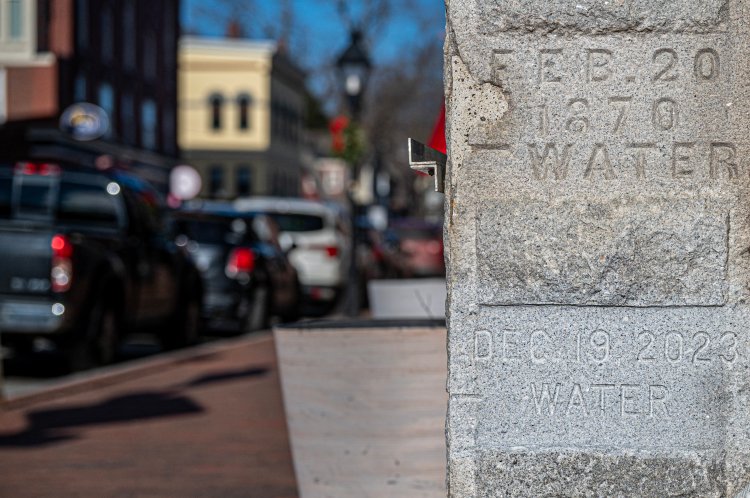
The water level from last year’s December flood is carved in a granite corner piece of the building at the intersection of Water and Central streets in downtown Hallowell. Joe Phelan/Kennebec Journal
Lapointe said it took two to three months for downtown Hallowell to feel normal after the December flood. Several businesses were closed for extended periods of time, and others never came back.
Some received aid from a City Council-approved relief fund, which directed $50,000 to businesses, with a cap of $2,000 per business. Others got help from private fundraising: One Quarry Tap Room employee’s husband raised more than $10,000 for the staff’s lost wages.
Vision Hallowell — a downtown support organization of which Joyall was recently appointed president — distributed more than $17,000 to downtown businesses following a monthslong fundraising campaign with other Hallowell community groups. The city matched that fundraising with another $17,000, which also went out to businesses impacted by the storm.
Lapointe said it would be easy for the city to beat itself up over its response to the flood. Not all business owners and tenants on Water and Front streets were on the city’s emergency contact list. Power restoration took longer than hoped. Lamb faced criticism for not invoking the city’s emergency management ordinance — which would have convened an eight-person committee of city leaders to coordinate response to the flood — but Lamb said the committee had never met, was not trained in emergency response and likely would not have been any more effective.
But above all the controversy and frustration, Lapointe said Hallowell should be proud of how it responded: The community came together to support its downtown, he said, in a relatively short amount of time.
“When there’s only so much you can do, people help out,” he said.
Maine
Killing of Sidney teen leaves community asking questions
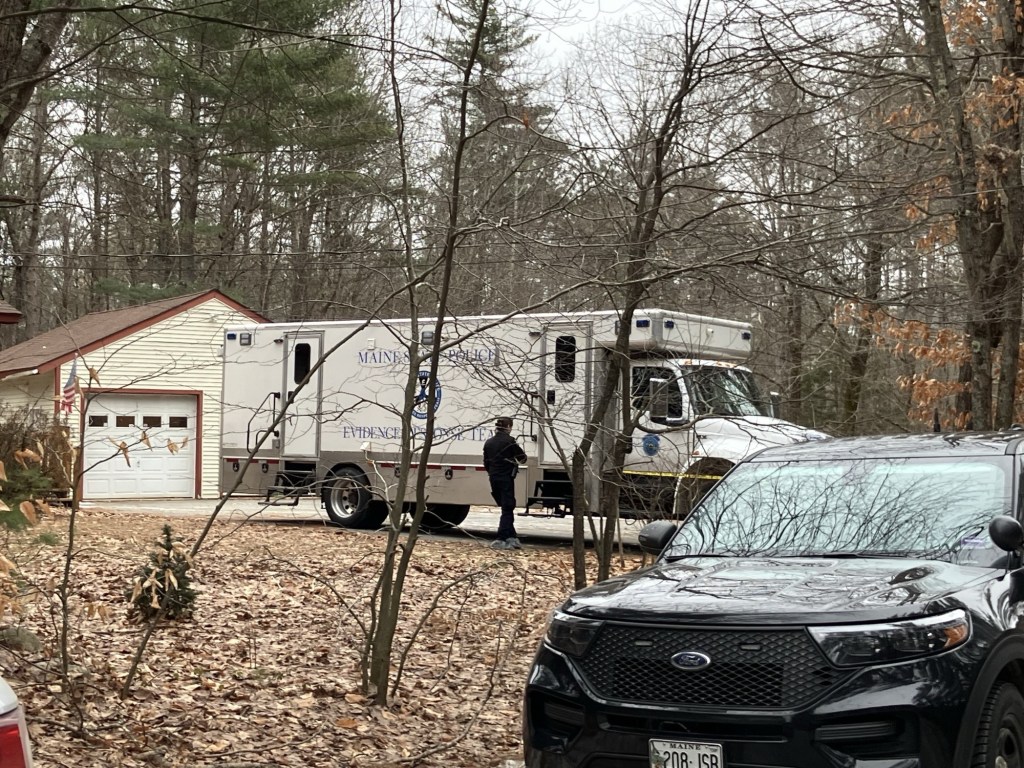

A home at 2005 Summerhaven Road in Sidney on Saturday is clear of the police tape that cordoned it off Friday while Maine State Police and local officers investigated the killing of a 14-year-old boy. A woman was arrested after reporting to the Androscoggin County Sheriff’s Office that a crime had occurred at the home early Friday morning. Ethan Horton/Kennebec Journal
SIDNEY — One day after a woman was arrested in connection with the homicide of a 14-year-old boy, residents of a residential neighborhood were left with more questions than answers, as police continued to withhold information about the boy and what exactly happened.


Police had left 2005 Summerhaven Road in Sidney by Saturday morning. There was little sign of the daylong investigation at the home Friday as snow flurries fell on a bitterly cold day.
Brady Maheux, 25, said he has lived his whole life on the windy, residential road near the Augusta-Sidney line, but did not know the people who lived in the house under investigation Friday.
“How does something like that happen?” said Maheux. “What the hell happened? It’s crazy.”
Megan McDonald, 39, was arrested Friday afternoon and charged with murder, Maine State Police said in a statement issued Friday evening. The arrest came after police found a 14-year-old boy dead outside the Summerhaven Road residence, state police said.


Megan McDonald Courtesy of Kennebec County jail
The Office of Chief Medical Examiner in Augusta determined the cause of the boy’s death as “a combination of asphyxiation, manual strangulation, and sharp force injury,” according to state police. The medical examiner’s office also ruled the manner of death as homicide.
Investigators were seen throughout the day Friday working at 2005 Summerhaven Road, a single-story home, with a detached garage flying a U.S. Marine Corps flag.
Town tax records list the property’s owner as Megan McDonald.
State police said they were called to investigate after Kennebec County sheriff’s deputies conducted a wellbeing check and found the dead teenager. The deputies were asked to conduct the check after a woman reported an incident at her home to the Androscoggin County Sheriff’s Office, according to state police.
Why the incident was reported there was not known Saturday. Just before 5:30 a.m., “an adult female arrived at the Androscoggin County Sheriff’s Office to report an incident that occurred at her home,” state police said Friday.
The Androscoggin County Sheriff’s Office, in Auburn, is about a 40-mile drive from the Summerhaven Road residence in Sidney, according to GPS mapping.
Androscoggin County Sheriff Eric Samson wrote in a message Saturday the woman who reported the crime in the Sheriff’s Office lobby was taken into custody, though he did not release that woman’s name. Samson referred further questions to a state police spokesperson.
Before police announced the homicide investigation Friday, Carl Gartley, superintendent of Regional School Unit 18, had sent an announcement to community members earlier in the day that a Messalonskee High School student had died. Sidney is one of the towns served by the Oakland-based district.
“Due to an ongoing police investigation, we are unable to release a name at this time,” Gartley wrote Friday.
Police and school district officials remained tight-lipped about the 14-year-old boy’s identity through the weekend, and it was not clear if the Messalonskee student who died was the one found dead on Summerhaven Road.
“I was hoping to release the name yesterday (Friday) but it’s ultimately up to the AG’s Office,” Shannon Moss, public information officer for the Maine Department of Public Safety, wrote in an email Saturday.
A spokesperson for the Office of the Maine Attorney General, which prosecutes all homicides in the state, did not respond to a message Saturday.
A woman retrieving her mail outside her home on Birch Circle, around the corner from the Summerhaven Road residence, said she knew the boy killed in the alleged homicide, but did not want to share any details publicly about him or provide her name until police release the name.
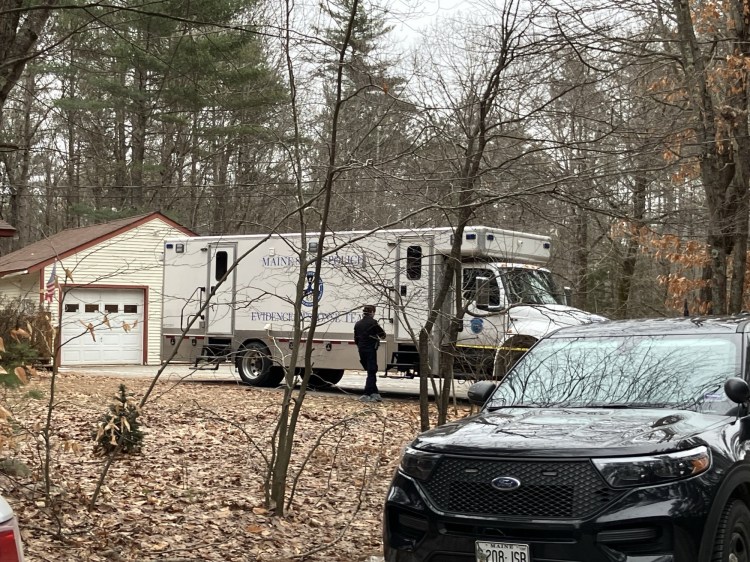

Several state police cruisers and a large Maine State Police Evidence Response Team box truck are parked at 2005 Summerhaven Road in Sidney on Friday afternoon. State police say they discovered the body of a 14-year-old outside of the home early Friday morning. Megan McDonald, 39, was taken into custody and charged with murder. Keith Edwards/Kennebec Journal
Another man, who has lived on Birch Circle for about 30 years, said he was cordial with the people that lived at the home where police were investigating but did not know them well. He was not sure how many people lived there and never knew them by name.
He called them “decent folks” and said he would see them if their dog got loose or when he was walking his dog in the area.
“There has been nothing that would’ve led you to believe there was anything wrong,” said the man, who declined to give his name because he did not want attention from other neighbors for speaking to the news media.
“Had we known, would we have done something?” he continued. “Of course.”
At several other nearby homes, residents either were not home Saturday morning or did not answer the door. Others who did answer the door said they did not know much beyond the information released by state police.
Maheux, the 25-year-old Summerhaven Road resident said he did not even hear or see police investigators arrive in the morning.
“I believe I was awake at that hour when they had gotten there,” Maheux said. “I never heard anything in the morning hours either.”
It is usually a quiet neighborhood, he said. “Nothing goes on out here.”
A neighbor of Maheux, who declined to provide his name, said the same, but recalled at least one other major incident nearby in recent years: a double homicide of an Augusta couple, found dead in the woods in Manchester, on Christmas Day in 2015. That killing was found to be related to drug dealing.
More information about Friday’s alleged homicide could emerge Monday, when McDonald would likely appear in court. If she remains in custody Monday, McDonald would be expected to make an initial court appearance in Kennebec County.
At that initial appearance, usually a brief hearing, a judge would read McDonald the charge against her. McDonald would not be required to enter a plea then, since prosecutors first need to present their case to a grand jury for an indictment before it could move forward.
It was not known Saturday if McDonald has an attorney. That information in Maine is only available through court clerk’s offices, which are closed on the weekends.
At Messalonskee High School in Oakland, about 14 miles north of the Sidney neighborhood, counseling sessions were available from 9-11 a.m., according to the announcement from school administrators.
Around 1 p.m., it was quiet around the school as a snow flurry fell. Only a handful of cars were in the parking lot, and there were no signs of any kind of memorials placed by community members.
“As we travel through our break, if you are in need, please do not hesitate to reach out for support,” the high school said in a Facebook post Saturday. “We are Messalonskee Strong.”
The post offered several resources:
• National Alliance on Mental Illness Maine: 1-800-464-5767, info@namimaine.org, call or text 988
• The Crisis Text Line: text “Home” to 741-741
• Crisis and Counseling Centers: 1-888-568-1112 or 207-626-3448
Sun Journal reporter Joe Charpentier contributed to this report.
-

 Politics1 week ago
Politics1 week agoCanadian premier threatens to cut off energy imports to US if Trump imposes tariff on country
-
/cdn.vox-cdn.com/uploads/chorus_asset/file/25789444/1258459915.jpg)
/cdn.vox-cdn.com/uploads/chorus_asset/file/25789444/1258459915.jpg) Technology1 week ago
Technology1 week agoOpenAI cofounder Ilya Sutskever says the way AI is built is about to change
-

 Politics1 week ago
Politics1 week agoU.S. Supreme Court will decide if oil industry may sue to block California's zero-emissions goal
-
/cdn.vox-cdn.com/uploads/chorus_asset/file/25546252/STK169_Mark_Zuckerburg_CVIRGINIA_D.jpg)
/cdn.vox-cdn.com/uploads/chorus_asset/file/25546252/STK169_Mark_Zuckerburg_CVIRGINIA_D.jpg) Technology1 week ago
Technology1 week agoMeta asks the US government to block OpenAI’s switch to a for-profit
-

 Politics1 week ago
Politics1 week agoConservative group debuts major ad buy in key senators' states as 'soft appeal' for Hegseth, Gabbard, Patel
-

 Business7 days ago
Business7 days agoFreddie Freeman's World Series walk-off grand slam baseball sells at auction for $1.56 million
-
/cdn.vox-cdn.com/uploads/chorus_asset/file/23951353/STK043_VRG_Illo_N_Barclay_3_Meta.jpg)
/cdn.vox-cdn.com/uploads/chorus_asset/file/23951353/STK043_VRG_Illo_N_Barclay_3_Meta.jpg) Technology7 days ago
Technology7 days agoMeta’s Instagram boss: who posted something matters more in the AI age
-
News1 week ago
East’s wintry mix could make travel dicey. And yes, that was a tornado in Calif.













